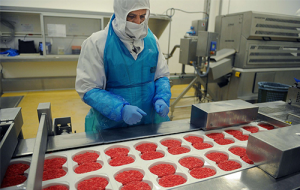The Myth of HEPA Filtration
High-Efficiency Particulate Air filters (HEPA) are commonly used to achieve a significant dust and particulate control. Hospitals and companies operating clean room fabrication labs use these types of filters to reduce the particulate contamination to acceptable levels. Properly installed and maintained HEPA filters undoubtedly reduce airborne contaminants. But this fact has spawned the myth that environments serviced by HEPA filters are free from contamination.
Like all filters, HEPA filters have an efficiency curve with a minimum in the range of 0.1- 0.3 μm. The particle removal efficiency for 0.3 μm particulate is 99.99%. However, reports1,2,3 show that as many as 50% of installed HEPA filters operate well below their theoretical efficiency due to:
- incorrect installation resulting in air bypassing the filter bank
- damage during the installation or service of the air handler, especially in settings where maintenance staff lack the specific training needed to maintain HEPA filters.
- trapped viable organic matter (e.g. fungi, bacteria, mold) that has grown through the filters In many cases a combination of the above factors compromises the efficiency level of HEPA filters.
Another way to look at HEPA filter protection is to determine the particulate allowed to pass through the filter because of its inherent 0.01% inefficiency. Assume that conservatively the HEPA will be challenged with 10,000 particles in the size range of 0.1-0.3 micron per cubic foot of air every minute (cfm) and that this HEPA filter is rated at 1,000 cfm. This HEPA will allow 10,000 particles to pass through every minute or 14,400,000 every 24 hours of operation.
While it is possible to reduce or eliminate damage during filter installation with the implementation of training and good operational procedures, it is more difficult to deal with the problems presented by viable organic contamination. With the exception of high end cleanroom fabrication labs, many facilities using HEPA filters are not staffed with technicians who have the knowledge necessary to maintain the environment that HEPA filtration is designed to provide.
Air handlers equipped with HEPA filtration usually have both pre-filters and secondary filters upstream to protect the HEPA filters. This minimizes the load and improves the life of the more expensive HEPA filters. With this design larger particles entering the air handler are therefore removed before they reach the HEPA filter.
This filtration scenario works well until viable organic matter starts the growth process within the HVAC system. Conditioning coils, particularly the cooling coils, are ideal for culturing microorganisms. The constant temperatures, moisture and an abundant food source equate to laboratory conditions for growing and sustaining a multi-species microbial population4. Eventually these organisms will travel downstream and become entrapped by the HEPA filter.
Filters treated with an antibacterial preservative typically show less tendency to develop microbial growth5. Under ideal conditions for microbial growth the treatment will, at the best, delay the process.
It is one thing to stop a small inorganic dust particle but a completely different thing to stop a small living organism. The situation becomes even more cumbersome if moisture is finding its way to the filter. This establishes conditions on the filter media that are similarly ideal to the ones on the coil. Again, studies show that when filters are loaded with microbial growth and moisture, it is very likely that the same organisms can be found on the supply side of the filters7.
The picture shows a typical final filter located downstream from the cooling coil at a hospital. The organic growth on the upstream side of the filter is clearly visible as white and dark areas (see arrows). Condensation water coming off the coil virtually saturated the filter. Besides creating an ideal environment for organism growth, the water also increased the delta pressure across the filter adding 1″ (W.G.). It is quite clear that this filter has lost much of its protective properties and instead assumed a roll as an incubator of contamination. Unfortunately this situation is not rare and can be found in many air handlers varied environmental settings.
Severe contamination of the cooling coil and drain pans are the root cause of this condition. The contamination causes water and organisms to come off the coil surface and travel down to the final filter. Fouled and clogged drain pans act as a secondary reservoir for microbial growth.
Contaminated air handlers not only yield reduced filtration efficiency, they also may increase indoor air pollution. Studies of office buildings suggest that once filters are colonized with fungi, they produce Volatile Organic Compounds (VOCs) that are offgassed, adding to indoor air quality problems6,7, especially for building occupants that are immune compromised or suffer from allergies.
Building owners who install VIGILAIR® Air Handler Protection Systems experience clean coils and drain pans. Coils are returned to their ‘as designed’ efficiency and drain pans work as intended instead of exacerbating the problem. Filters remain dry and free from viable organisms. Microorganisms captured by the dry filter will find it difficult to survive and reproduce.
In summation, the HEPA filter is the highest efficiency filter available for HVAC systems. Like all filters there exists a determinable inefficiency that belies the myth of the HEPA as an ‘absolute’ solution to airborne contamination removal. The presence of microbial matter within HVAC systems raises the bar for contamination control of conditioned environments.
VIGILAIR® is a proven, highly effective system that provides an uncontaminated air handler environment. High efficiency Ultraviolet Germicidal Irradiation (UVGI) ensures that cooling coils are completely free from organic growth. VIGILAIR® UVGI compatible filters allow UVGI exposure of the filter surfaces which ensures inactivation of any organisms trapped on the filter surface.
References
- Michele R. Evans, David K. Henderson, Infection Control in the Healthcare industry in the 21stCentury, Hospital Engineering & Facilities Management 2005, Issue 2 pp. 58-62
- Colin Perllman, Are Hospitals Getting Left Behind?, Cleanroom Technology, October 17, 2005
- Andrew Streifel, Control Factors in Hospital Building Maintenance and Operations, Hospital Engineering & Facilities Management 2005, Issue 1 pp. 55- 58
- R.B. Simmons, D.L. Price, J.A. Noble, S.A. Crow, D.G. Ahearn, Fungal Colonization of Air Filters from Hospitals, AIHA Journal (58) December 1997
- D.L. Price, R.S. Simmons, S.A. Crow, D.G. Ahearn, Mold Colonization during Use of Preservative-Treated and Untreated Air Filters, Including HEPA Filters from Hospitals and Common Locations over an 8-year Period(1996-2003), Journal of Industrial Microbiology Vol. 32: 319-321
- M. Möritz, H. Peters, B. Nipko, H. Rüden, Capability of Air Filters to Retain Airborne Bacteria and Molds in Heating, Ventilating and Air-conditionng (HVAC) Systems, Int. J. Hyg. Environ. Health 203, 401-409 (2001)
- D.G. Ahearn, S.A. Crow, R.B. Simmons, D.L. Price, S.K. Mishra, D.I. Pierson, Fungal Colonization of Air Filters and Insulation in a Multi-Story Office Building: Production of Volatile Organics, Current Microbiology, Vol. 35 (1997)
HEADQUATERS
PG35, Damansara Perdana Shopping Centre, Jalan PJU 8/1, 47820, Petaling Jaya, Selangor, Malaysia
TEL : 0377332757 EMAIL:info@ansrcare.com
BRANCH
Lot 3484 B, Tingkat Bawah Wisma Seri Panji Alam Jalan Panji Alam 21100 Kuala Terengganu, Terengganu Darul Iman.
TEL:096229270 EMAIL:info@ansrcare.com
ANSRCARE.COM © 2018, All Rights Reserved. Web Design By BG Design







